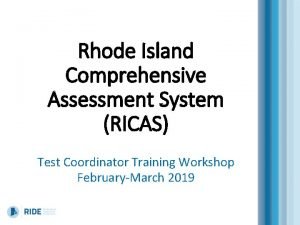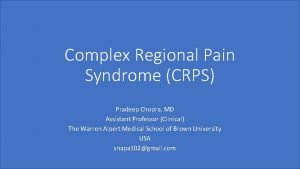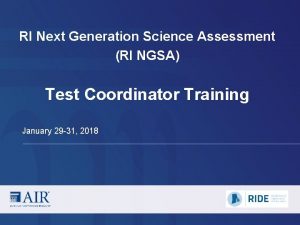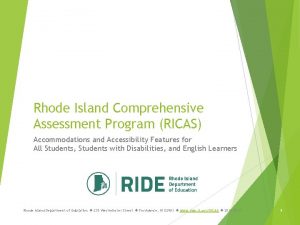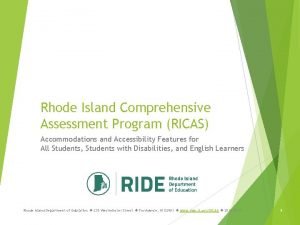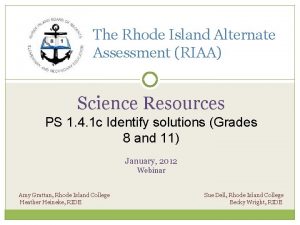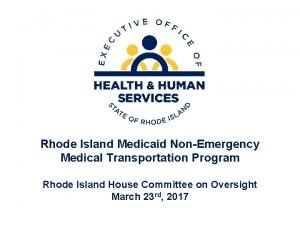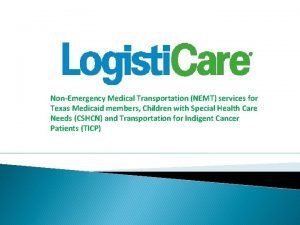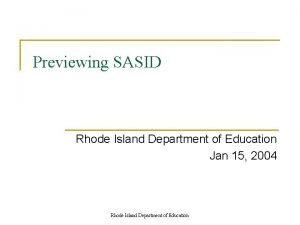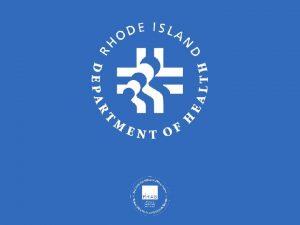Nicole AlexanderScott MD MPH Director Rhode Island Department



















- Slides: 19

Nicole Alexander-Scott, MD, MPH Director, Rhode Island Department of Health March 26, 2019

Outline • The Rhode Island Department of Health (RIDOH)’s Strategic Priorities • Two approaches to shift investments: • Clinic-to-community • Direct to community (RI HEZs) • Interagency Collaboration

Higher spending doesn’t lead to better health The US spends a lot more than other developed countries on healthcare. . . Yet our life expectancy is worse.

We are Under-Investing in Social Services For every $1 spent on healthcare: • Most countries* spend $2 on public health and social services. • But the US only spends 55 cents! * Organization for Economic Co-operation and Development (OECD) member countries

Health Starts in our Communities 80% of what matters for health happens outside the doctor’s office, inside our homes, schools, jobs, and communities. Determinants of Health Model based on frameworks developed by: Tarlov AR. Ann N Y Acad Sci 1999; 896: 281 -93; and Kindig D, Asada Y, Booske B. JAMA 2008; 299(17): 2081 -2083.

RHODE ISLAND STATEWIDE INTEGRATED POPULATION HEALTH LEADING PRIORITIES, STRATEGIES, AND GOALS Three Leading Priorities Guide Our Work Address the Socioeconomic and Environmental Determinants of Health in Rhode Island Eliminate the Disparities of Health in Rhode Island Promote Health Equity Ensure Access to Quality Health Services for Rhode Islanders, Including Our Vulnerable Populations Five Strategies Will Move Us Forward 23 Integrated Population Health Goals and Metrics Align with Statewide Healthcare Planning

KEY: Red arrow = Directly related to behavioral health outcomes Green arrow = Goal that supports positive behavioral health outcomes * These goals have been proposed through the State Innovation Model and are under review.

Outline • The Rhode Island Department of Health (RIDOH)’s Strategic Priorities • Two approaches to shift investments: • Clinic-to-community • Direct to community (RI HEZs) • Interagency Collaboration

Community Health Workers Hired for their lived experience and understanding of the populations they serve (rather than just from expertise due to formal education). Examples include: • • Chronic disease case managers Substance use disorder peer recovery specialists Bi-lingual health systems navigators Public Housing Resident Coordinators

Transforming Practices with CHWs

Transforming Practices with CHWs

Outline • The Rhode Island Department of Health (RIDOH)’s Strategic Priorities • Two approaches to shift investments: • Clinic-to-community • Direct to community (RI HEZs) • Interagency Collaboration

Health Equity Zones Novel approach to funding public health at the community level. Equips diverse residents and partners to collaborate to create healthy places to live, learn, work, play. Our goal: lasting transformation. • Identifying sustainable, flexible funding is key. Health Equity Zones

Health Equity Zones: Results to Date Nine Healthy Equity Zones across RI • Formed community-led Collaboratives • Conducted baseline needs assessments • Created Plans of Action targeting measurable outcomes based on effective strategies • Implementing and evaluating Plans of Action

Health Equity Zones: Behavioral Health Outcomes • 13% decrease in feelings of loneliness (West End, Elmwood, South Providence) • 46 people were diverted from the criminal justice system to local opioid treatment and recovery support services (West Warwick) • Evidence-based mental health first aid and suicide prevention training provided to 1000+ partners (Washington County) • $2 M in federal funding secured to implement Zero Suicide initiative (Washington County) • 163% increase in community engagement (HEZs Statewide) • National focus on HEZ, social isolation, and community resilience through ASTHO President’s Challenge

Outline • The Rhode Island Department of Health (RIDOH)’s Strategic Priorities • Two approaches to shift investments: • Clinic-to-community • Direct to community (RI HEZs) • Interagency Collaboration

Interagency Collaboration – Suicide Prevention • Collaborating with BHDDH and HARI to promote the Campaign to Change Direction • Supporting Office of Veterans Affairs in SAMHSA’s Governor’s Challenge to Prevent Suicide among Service Members, Veterans and their Families • RI has moved from having the 18 th lowest teen suicide rate in 2016 to the lowest rate in the country in 2018

Interagency Collaboration – Drug Overdose • Recent updates to Governor Raimondo’s Overdose Prevention and Intervention Task Force Strategic Plan keeps the focus on reducing overdose deaths and saving lives – and adds cross-cutting workstreams that address the causes of the opioid crisis. • For the first 10 months of 2018, Rhode Island saw a 6. 1% decrease in opioid-related overdose deaths, compared to the first 10 months of 2017.

Nicole Alexander-Scott, MD, MPH Director, Rhode Island Department of Health Nicole. Alexander. Scott@health. ri. gov
 Risbdc
Risbdc Rhode island comprehensive assessment system
Rhode island comprehensive assessment system Pradeep chopra md
Pradeep chopra md Rhode island environmental police
Rhode island environmental police Ri ngsa
Ri ngsa Ricas graphic organizer
Ricas graphic organizer Galinha rhode island red
Galinha rhode island red Ricas accommodations and accessibility features manual
Ricas accommodations and accessibility features manual Ri board of governors
Ri board of governors Rhode island comprehensive assessments system
Rhode island comprehensive assessments system Does logisticare pay weekly or biweekly
Does logisticare pay weekly or biweekly Stem cell treatment rhode island
Stem cell treatment rhode island Interesting facts rhode island
Interesting facts rhode island Medicaid medical transportation program texas
Medicaid medical transportation program texas Rhode island stormwater manual
Rhode island stormwater manual Rhode island
Rhode island Island of the blue dolphins island map
Island of the blue dolphins island map A or an island
A or an island Angel vs ellis island
Angel vs ellis island Ellis island and angel island venn diagram
Ellis island and angel island venn diagram

